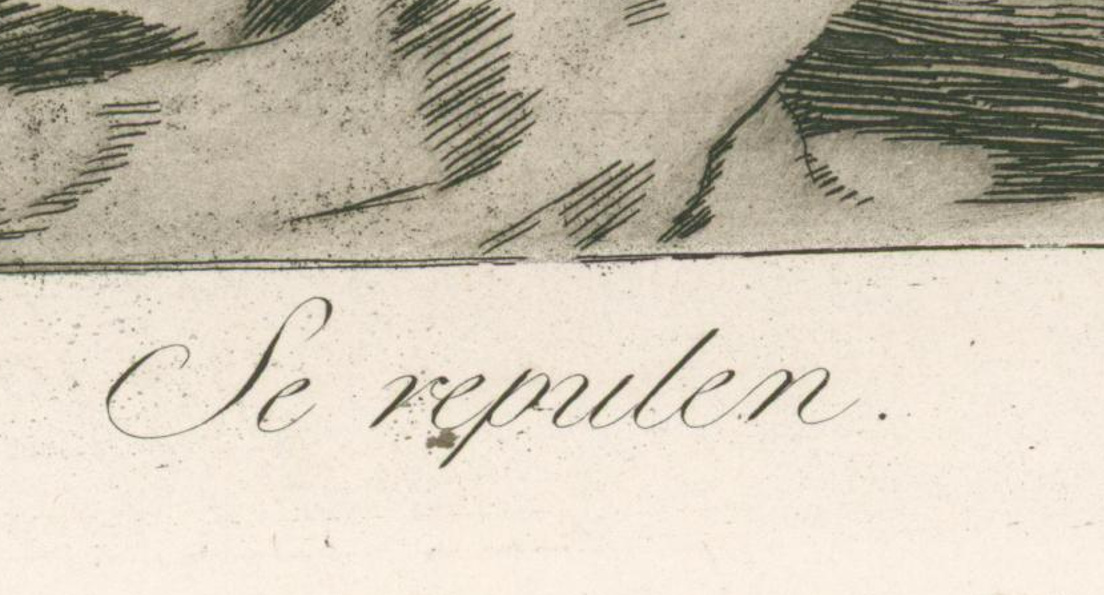


Francisco de Goya, Los Caprichos, Se Repulen - (6th edition Plate 51) (1878–1900)
Corruption remains a spectacle worthy of ridicule.
Goya, Spain’s greatest Romantic printmaker, infused Los Caprichos (1799) with biting satire and haunting allegory.
This print, a rare and blistering commentary on the abuses of wealth and power, feels uncannily modern. Just as Goya satirized the greed and corruption of eighteenth-century elites, today we witness the same patterns in global dictatorships and in the shameless enrichment of figures such as Donald Trump. The enduring power of Goya’s art lies in its fearless exposure of folly and vice: it mocks the powerful, strips away their pretensions, and reminds us that corruption, whether in Bourbon Spain or twenty-first-century America, remains a spectacle worthy of ridicule.
“A condemnation of the officials who aid and abet each other in embezzling the wealth of the state, while seeking to maintain social respectability”
This print is from Goya’s original copper plates. Etching, aquatint, drypoint, and burin. Published by Calcografía Nacional, Madrid, the Spanish national archive and cultural institution, part of the San Fernando Royal Academy of Fine Arts, established in 1789 to conserve the legacy of Spanish graphic art.
In 1803 Goya donated the complete original copper plates to the King of Spain, who then entrusted them to the Calcografía Nacional.
Title : Se Repulen (They spruce themselves up) Goya commented:
"This business of having long nails is so pernicious that it is forbidden even in witchcraft." Goya mocks the notion that ghouls are concerned with their personal appearances. At least one contemporary commentator associated
long nails with public theft and corruption. One might therefore read this image as a condemnation of the officials who aid and abet each other in embezzling the wealth of the state, while seeking to maintain social respectability.” The complete prints of Francisco de Goya, Miguel Orozco
Dimensions 8 3/4” x 12 1/2”
Excellent Condition - well inked with margin. Excellent coloring.
Collector’s note This example is a Calcografía Nacional posthumous edition (c. 1878–1900), printed on wove ivory paper without watermark. Key features confirm this edition: the printed caption Ensayos beneath the plate and softened aquatint tones from plate wear. While not as scarce as the 1799 first edition, these impressions remain highly collectible. They were pulled from Goya’s own copper plates, offering direct continuity with his hand.
Corruption remains a spectacle worthy of ridicule.
Goya, Spain’s greatest Romantic printmaker, infused Los Caprichos (1799) with biting satire and haunting allegory.
This print, a rare and blistering commentary on the abuses of wealth and power, feels uncannily modern. Just as Goya satirized the greed and corruption of eighteenth-century elites, today we witness the same patterns in global dictatorships and in the shameless enrichment of figures such as Donald Trump. The enduring power of Goya’s art lies in its fearless exposure of folly and vice: it mocks the powerful, strips away their pretensions, and reminds us that corruption, whether in Bourbon Spain or twenty-first-century America, remains a spectacle worthy of ridicule.
“A condemnation of the officials who aid and abet each other in embezzling the wealth of the state, while seeking to maintain social respectability”
This print is from Goya’s original copper plates. Etching, aquatint, drypoint, and burin. Published by Calcografía Nacional, Madrid, the Spanish national archive and cultural institution, part of the San Fernando Royal Academy of Fine Arts, established in 1789 to conserve the legacy of Spanish graphic art.
In 1803 Goya donated the complete original copper plates to the King of Spain, who then entrusted them to the Calcografía Nacional.
Title : Se Repulen (They spruce themselves up) Goya commented:
"This business of having long nails is so pernicious that it is forbidden even in witchcraft." Goya mocks the notion that ghouls are concerned with their personal appearances. At least one contemporary commentator associated
long nails with public theft and corruption. One might therefore read this image as a condemnation of the officials who aid and abet each other in embezzling the wealth of the state, while seeking to maintain social respectability.” The complete prints of Francisco de Goya, Miguel Orozco
Dimensions 8 3/4” x 12 1/2”
Excellent Condition - well inked with margin. Excellent coloring.
Collector’s note This example is a Calcografía Nacional posthumous edition (c. 1878–1900), printed on wove ivory paper without watermark. Key features confirm this edition: the printed caption Ensayos beneath the plate and softened aquatint tones from plate wear. While not as scarce as the 1799 first edition, these impressions remain highly collectible. They were pulled from Goya’s own copper plates, offering direct continuity with his hand.
